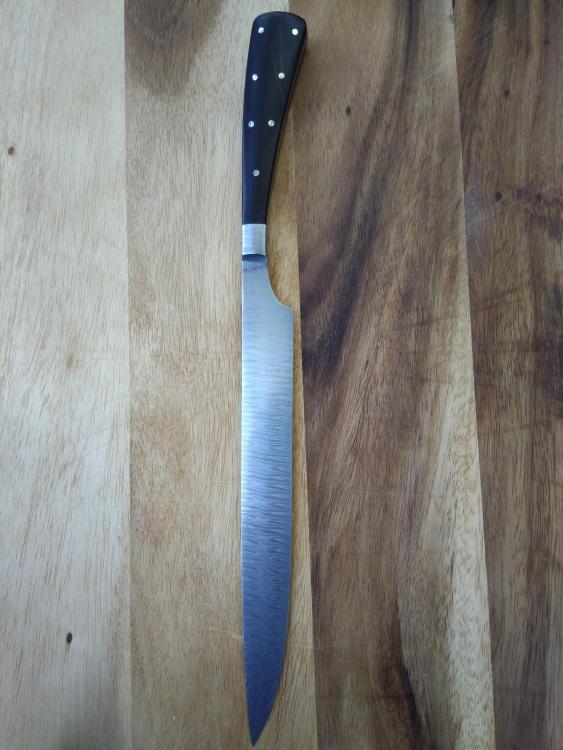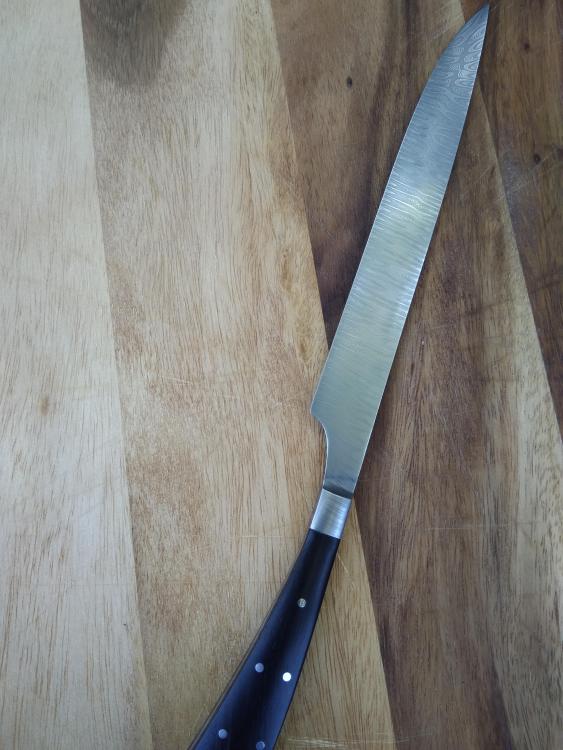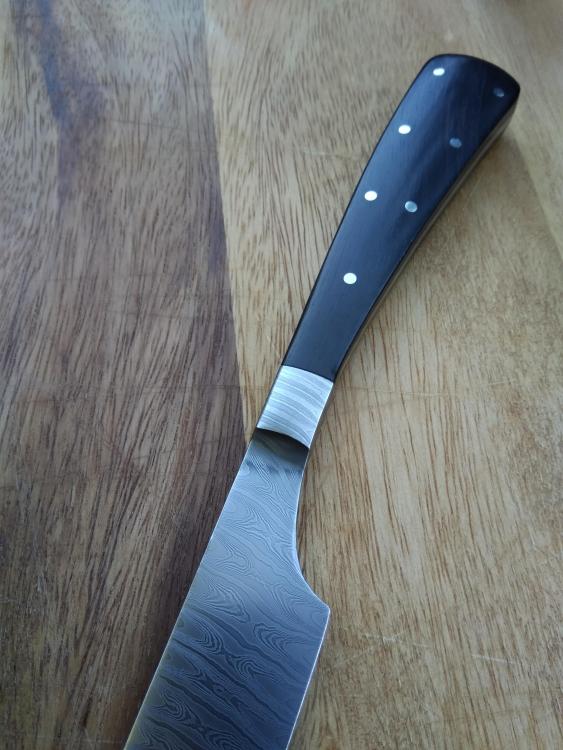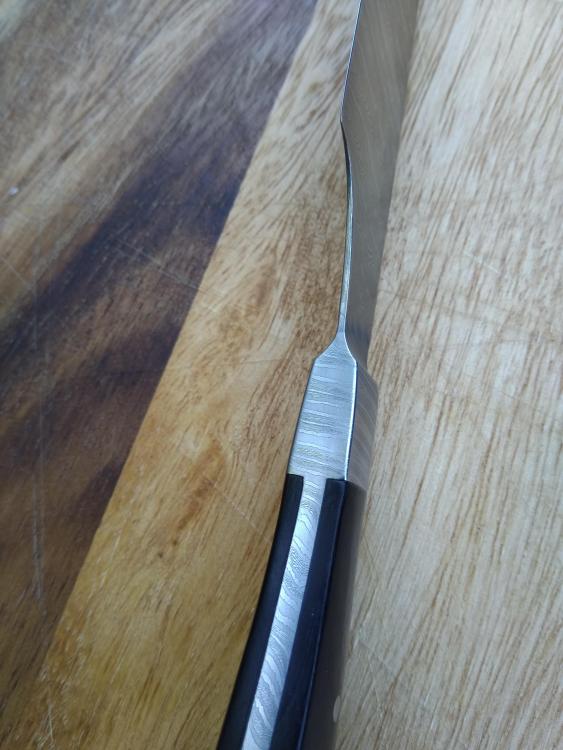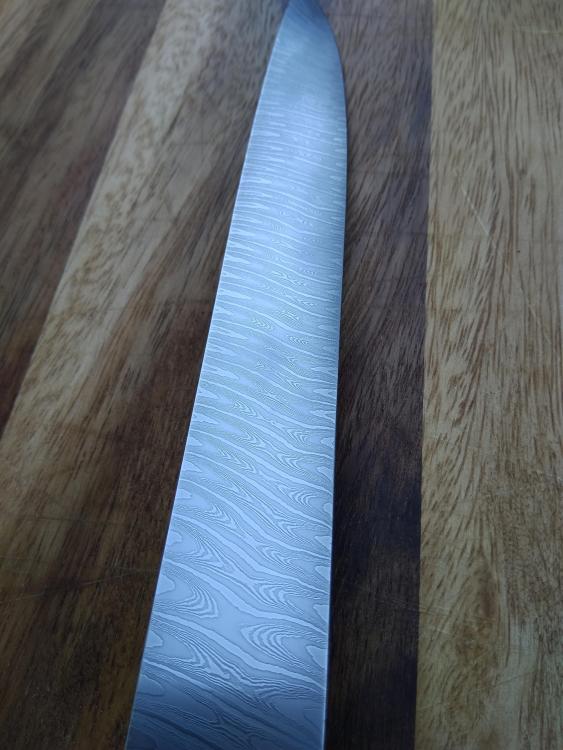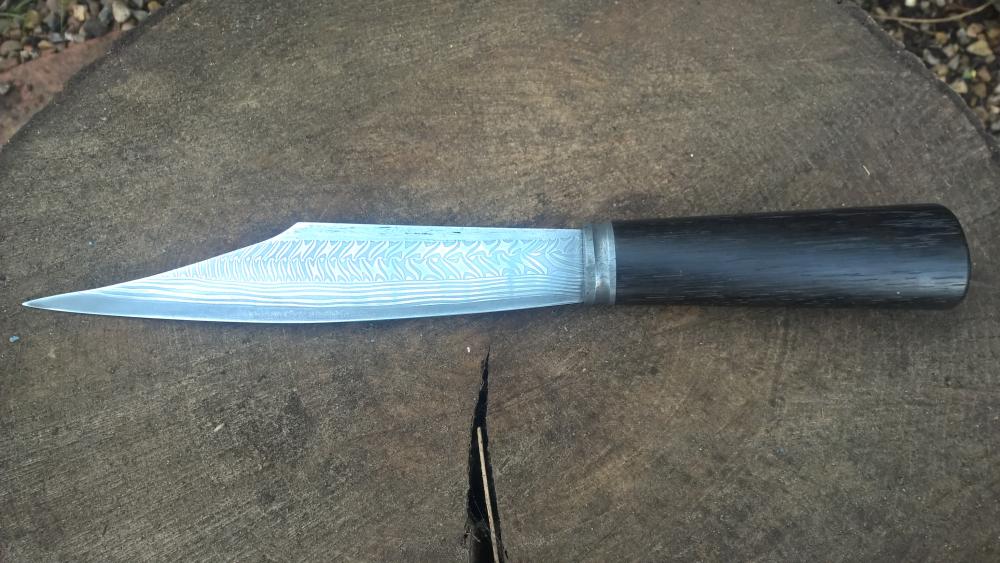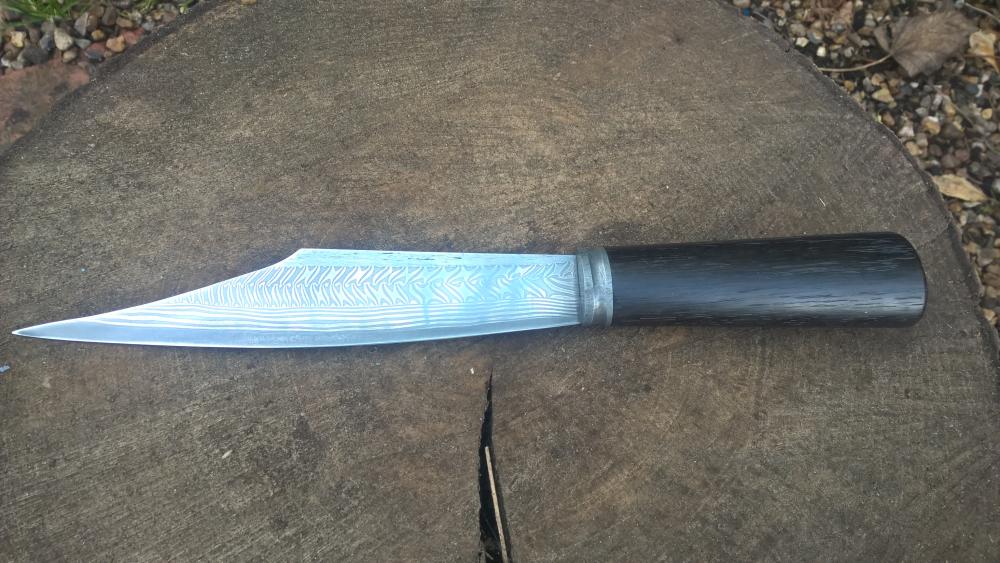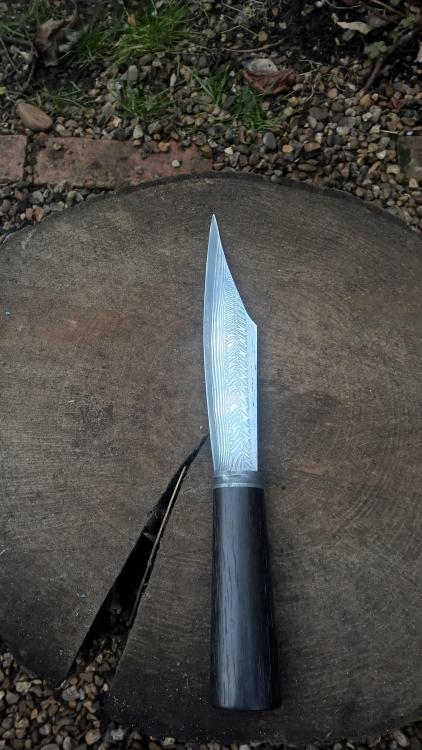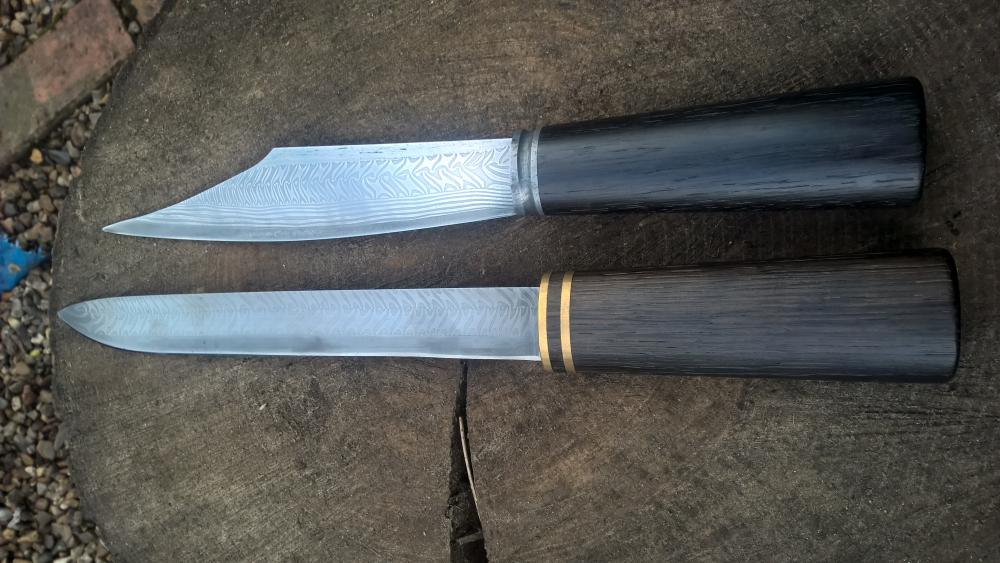-
Posts
223 -
Joined
-
Last visited
Content Type
Profiles
Forums
Articles
Gallery
Downloads
Events
Everything posted by Foundryman
-
The idea had occurred to me!
-
Thank you for the kind comments. The wedding went off without a hitch and the knife was very well received. It has now been sharpened ready for a lifetime of service as a carving knife.
-
Thank you, I appreciate it!
-
That grind line isn't terrible, you could easily clean it up with hand sanding, just use your belt grinder to grind yourself a sanding block the same radius as your contact wheel and go at it, you'll tidy everything up in no time.
-
Thanks, it's the first time I've made a knife with any kind of bolster, it took lots of careful filing!
-
Thanks for the kind comments guys, they mean a lot!
-
Beautiful work, you always get such a tight fit and finish!
-
My brother asked me to make a knife for him to cut the cake for his wedding. Both he and his wife to be wanted to be involved in the making of the knife so they came over and struck for me when I was drawing out the Damascus billet. The knife is 15 inches long and made up from 13 layers of 15n20, 1095 and 20C (two of the inner layers are made of up of 15 layers each) twisted tightly and forged to shape with an integral bolster. The handle is African blackwood and stainless steel pins. I deliberately left the knife blunt to avoid any accidents on the big day however it's still more than sharp enough to cut cake. This is my first time doing an integral bolster, it's also the longest, thinnest knife I've made so far.
-
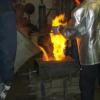
One more pattern welded this time with file work
Foundryman replied to Zachary's topic in Knife Making
Nice work, the pattern came out nicely and you got a really clean polish and etch, it looks great! -
I had a bunch of planer blades at one point but they turned out to be high speed steel I believe, which is useless to me. They gave off very odd sparks when put to the grinder, closer to cast iron than anything else!
-
I moved a 1cwt aldays and onions power hammer last year using the exact same method, it's simple and it works, why complicate things!
-
It all seems very ambiguous at the moment, what constitutes a knife? Can you still sell bare blades? Are seaxes knives or short swords?
-

Some of my recent work - comment/critiques wanted (pic heavy)
Foundryman replied to billyO's topic in Knife Making
They're all beautiful blades but it's your handles I find myself looking at, great choice of materials and finish, nicely done. -
I finish ground and polished my prototype blade today and it's 2.25mm~ at the heel tapering down towards the tip, so fairly thin I guess. I'd say that it's actually lighter and thinner than her current Santoku knife, though I doubt the blade weight would be an issue anyway, my mum grew up carrying 50lb sacks of coal in my grandad's hardware store so she's stronger than most I'd guess. I guess that means the chefs knives I generally make are German style with more curved blades, I certainly use more of a rocking motion than a push cut during food prep. I'm glad I asked the question now, thank you for sharing your knowledge guys, it's very much appreciated!
-
Thanks for the feedback guys, it's given me a lot to think about. That 17" chefs knife is a beast Charles! The Chinese cleaver is cool too, something I'd like to try out sometime and I love the patina on your knives, it really gives them character. The rounded tip is an interesting idea, and at 2.5mm thick I can understand why you love it, it must cut like a laser. My go to paring knife has a very similar handle to what you describe and it sure is comfortable to use and indexes to your hand nicely. Funny that you should mention the Japanese slicer, it's already on my list of future projects though I honestly think it would end up only being used as a carving knife. I made a nakiri last year with a chisel grind and in terms of sharpness it's by far the best performing blade I've made though I couldn't get on with it when it came to dicing onions because of the lack of a pointed tip held it back. My 1095 prototype came out of the tempering oven last night so i'll hopefully get it finished up today and go from there.
-
She has a 7" chefs knife and a 8" Santoku that she uses a lot but I wanted to give her something different/special, the question was more from a practicality point of view. I tend to grind my kitchen knives all the way from the spine to 0 for maximum sharpness. 10" is a long blade! Can I ask what the spine thickness is on that one? I try to keep below 3mm (1/8") otherwise the blades just become too heavy and lose the ability to slice cleanly.
-
Let me start by saying I've made a fair number of kitchen knives to date in differing sizes (I think the count is 11, 4 of which being chefs knives all in the 7"-7 3/4" range). I've recently designed a large chef knife as a gift for my mother and it got me thinking how big is too big? My mother semi regularly does catering events for her church, cooking for upwards of 40 people several times a year so this knife will get put through it's paces. It's intended for general food prep, slicing meat and rough chopping vegetables. The knife itself has a 9" blade and overall is 13 3/4". After sketching the blade up in full size I'm happy with the proportions visually but I'm unsure how it'll actually perform so this afternoon I ground out a prototype in 1095 so I can try it before committing to forging the damascus for the final version. I've come across several pitfalls before such as some of my early blades being too thick to cut well (they behaved more like axes on harder vegetables such as potatoes, carrots etc) and not leaving enough clearance on the handles for your knuckles while chopping but I've never come across size being an issue. So this brings me to my question, what size do you generally go for on your chef knives and what lead you to that decision? Has anyone had any issues where a blade they've made has just been too large to be comfortable or even practical for general food prep use? Simon.
-
I'd say a friction folding seax would suit your criteria and would also be complimented by your choice of materials.
-

Beat up anvil
Foundryman replied to Timber Ridge Forge's topic in Anvils, Swage Blocks, and Mandrels
I'd be tempted to believe the weight estimate, that looks like very wide faced anvil which can be a pretty good indicator of a heavy anvil when guesstimating from photos. -
You sure are busy, nice work! I particularly like the profile on the paring knife!
-
He does the same process in a lot of his videos, including ones from freshly ground, stacked steel and even a billet made from screws welded together, which is why I think it's to prevent oxidation more than anything else. Whether it actually works is another matter but I can't think of another reason why you would soak a billet of clean steel in liquid before putting it in the forge.
-

Coffin handle Sheffield Bowie in damascus with hamon
Foundryman replied to TheoRockNazz's topic in Knife Making
The pattern on the blade is cool, but the handle is just stunning, great choice of materials! -
I've seen this guys videos before and I always assumed it was kerosene. I think the idea is that it burns off using up any free oxygen in the forge before it can oxidise the steel, protecting it until its hot enough to apply flux or even allowing you to weld without flux. Hopefully a more experienced smith will chime in and confirm this or tell me I'm talking rubbish.
-
Thanks for the feedback guys, I appreciate it. I wanted the bolster to tie the handle into the blade so used wrought iron which I etched fairly deeply. I love using bog oak for my handles, it's nice to work with and native to the UK which I appreciate.
-
I finished up this knife over the weekend. The blade is made up of 5 bars forge welded together. The spine is wrought iron, the next two bars are twisted 15n20 and 1095, then 15 layers of 15n20 and 1095 with an O1 edge. The handle is bog oak with an etched wrought iron bolster. The overall length is exactly 12" with a 7 3/8 blade. It's just over 1/4" at the broken back and 3/16 at the bolster. Next weekend I hope to make a start on a sheath for it. This is it next to a 3 bar langseax I made two years ago which I'm tempted to re-grind and re handle as I've never been quite happy with the etch or handle on it but it's nice to see the progress between the two.

